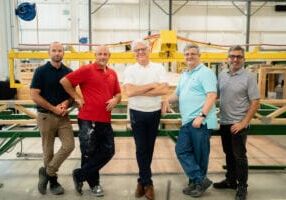Did the Pandemic Bolster Modular Construction's Long-Term Outlook?
A new report from Anirban Basu, chairman & CEO of Sage Policy Group and Chief Economist of the Modular Building Institute

Anirban Basu is chairman & CEO of Sage Policy Group and Chief Economist of the Modular Building Institute
The Answer Appears to be “Yes, it did”
The pandemic of 2020 and beyond not only ended the lengthiest economic expansion in American history, it has also fundamentally altered behavior. In some instances, this has compromised the long-term outlook for certain key construction segments, including the office market (remote work), hotels (remote meetings), and shopping centers (remote shopping). But in many other instances, has rendered modular construction even more competitive, thereby improving its long-term outlook in terms of construction market share and overall activity.
Workforce Considerations
The natural place to begin such a discussion is with the construction workforce. To state the situation as succinctly as possible, it’s too small and under-trained. In this regard, the pandemic didn’t help. It caused many Baby Boomers to retire earlier than anticipated, in part to avoid Covid infection during the pre-vaccination period. But the pandemic also helped launch a surge in asset prices, whether in the form of rising home values or bloated stock portfolios. Many Boomers determined that they had become wealthy enough to retire, and so they did.

Anirban Basu speaks at the 2022 World of Modular conference and tradeshow.
The problem is that many of North America’s most talented construction workers are Baby Boomers, people who nurtured their skills as craftspeople for decades. Their departure from the workforce has not been neatly offset by the entry of younger skilled workers, helping to produce skills and worker shortages in the process. Much of the construction industry has responded by ramping up hiring of unskilled laborers, with the hope that they could help get products across the proverbial finish line and eventually be trained to become more productive.
There’s more. Construction has traditionally depended heavily upon the efforts and talents of immigrants. Recent presidents have tended not to favor stepped up legal immigration. Partially as a consequence, the size of the working age immigrant population is much smaller than it would have been had pre-2017 trends remained in place.
Worker preferences have also shifted during the pandemic, with more seeking to work remotely and/or enjoy greater flexibility. Such preferences do not suit construction well, given that virtually all construction work must be performed at a jobsite and that a significant volume of construction services is delivered by teams. Construction, therefore, cannot offer the types of flexibility that might be available to white collar workers or to those in the gig economy who do things like drive for Lyft or Uber.
Even in the context of Baby Boomer engagement, during their prime working years, construction productivity lagged. According to data compiled by the Bureau of Labor Statistics and analyzed by Steven G. Allen in 1985, “productivity in the construction industry reached a peak in 1968 and, except for a brief and small upturn between 1974 and 1976, has been falling ever since.”
Recent data indicate much the same thing. Data show that between 2007 and 2020, overall construction productivity was flat, though as pointed out by three economists at the Bureau of Labor Statistics, productivity has actually been rising in especially capital-intensive segments like industrial construction and high, street and bridge construction.
Nonetheless, given the industry’s propensity to deliver projects beyond budget and deadline, greater productivity would be most welcome, especially as America seeks to dramatically improve its roads, bridges, airports, seaports, electrical grids, and water systems. That craving for better outcomes favors modular construction. A 2019 McKinsey report regarding modular construction stated that the productivity boost of the off-site production sometimes shortens timelines by 20 to 50 percent.
Modular construction is also far more likely to meet the tastes and preferences of younger workers. By operating in controlled settings, modular construction employers are able to keep employees more comfortable, remove variables such as wind and rain, and perhaps even offer more flexible working arrangements since workers are more likely to be interchangeable to the extent that they engage in repetitive tasks uncompromised by the vagaries of the outside world.
Environmental Concerns
There is also a growing demand for rapid improvements in environmental outcomes, something reinforced by the pandemic and a desire for more climate and biological stability. The construction industry is rarely considered especially friendly to the environment. A study from the Global Alliance for Building and Construction states that the global construction industry is “responsible for almost 40 percent of energy- and process-related emissions”. Other reports estimate that the amount of waste generated by construction totals around 56 million tons of debris.
Modular construction mitigates these environmental impairments in multiple ways. First, by operating in controlled, indoor settings, modular construction can contain the release of chemicals, dust, and other byproducts. Air filters can add to environmental protections. Byproducts are more easily captured and recycled. Moreover, many of today’s modular structures come with integrated solar panels, favor dimmable LED lighting, sensors that detect when people are present, and triple-paned windows. Fiction Factory, a construction studio based in Amsterdam, produces the Wikkelhouse, a completely modular home that is fully biodegradable. Nonetheless, they are built to last for decades.
Autovol, a modular construction company based in Idaho, is increasingly taking advantage of robotics, another technical feature likely to be easier to introduce in modular settings. In a Construction Dive piece, CEO Rick Murdock indicates that a bit less than a third of its production process is conducted robotically and that he expects that number to rise to 45 percent in the future. The company is also employing women at a significantly higher rate than non-modular construction segments. Whereas women comprise approximately 5 percent of total construction workers, they hold nearly one in three jobs at Autovol.
Looking Ahead
With interest rates rising and risk of recession elevated, the near-term could prove challenging for many modular and non-modular construction firms alike. But societal shifts wrought by the pandemic have rendered modular construction’s narrative all the more compelling, which should set the stage for larger market share gains going forward.
More from Modular Advantage
Resia: Breaking All the Rules
Resia Manufacturing, a division of U.S.-based Resia, is now offering prefabricated bathroom and kitchen components to industry partners. Its hybrid fabrication facility produces more precise bathroom and kitchen components (modules) faster and at lower cost than traditional construction. Here’s how Resia Manufacturing does it.
How LINQ Modular Innovates to Bring Modular To The Market in the UAE and Beyond
LINQ Modular, with an office and three manufacturing facilities in Dubai, is a modular firm based in United Arab Emirates. The company is on a mission: to break open the housing and construction markets in the Gulf Cooperation Council (GCC) area with modular.
ModMax: Redefining Modular Construction with Confidence and Precision
ModMax was born out of frustration—frustration with five persistent pain points in modular construction: Permitting bottlenecks. Production delays. Rigid designs. Disconnect between “the office” and the field. Lack of transparency and communication.
LifeArk: Disaster-Resilient Housing from Recycled Plastic and 100-year-old Technology
Wee compares LifeArk’s housing units to Yeti coolers, as they are built similarly. Each component takes 15 to 20 minutes to manufacture, has an R-value of 40, and includes molded slots and chases for wiring, plumbing, fire sprinklers, and other utilities.
Building the Future of Modular Edge Infrastructure
The edge data center market is expanding rapidly, driven by the surge in AI workloads, IoT adoption, and the need for localized compute power. In these environments, sustainability, scalability, and reliability are non-negotiable. Cooling is among the most complex challenges for operators—and one of the most decisive factors in long-term success.
Accelerating Light-Gauge Steel Construction: A Semi-Automated Digital Workflow for Off-Site Projects
For construction professionals, the message is clear. By adopting semi-automation and digitalization, companies can deliver projects faster, more accurately, and more profitably, while also building stronger collaboration across teams. The approach is not about replacing people with machines, but about empowering people with better tools and processes.
Why Modular Data Centers Are Gaining Momentum
Artificial intelligence, high-performance computing, and edge applications push the limits of traditional “stick-built” data centers. They take years build, often struggle with high density workloads, and aren’t optimized for deployments near end users. Modular data center platforms are purpose-built to address these challenges, offering flexibility and scalability to adapt to evolving technologies, while opening new opportunities for the modular construction industry.
Supply Chain Innovation in Action: 5 Habits Every Modular Leader Should Practice
By applying these principles to supply chain practices — collaborative planning, strategic procurement, scenario modeling, digital tools, and transparent forecasting — construction leaders can build value chains that are not just efficient and agile, but truly innovative.
Exploring the Role of Modular Integrated Construction (MiC) in Advancing Circular City Principles – A Survey of Stakeholder Perspectives
The survey findings highlight the significant potential of Modular integrated Construction (MiC) in advancing the development of circular cities. By reducing costs, accelerating construction timelines, and minimizing waste generation, MiC offers a promising approach to sustainable urban development.
The Use of MS POLYMER™-Based Sealants and Adhesives in Modular Building
These products combine flexibility and elastic recovery with excellent adhesion to different substrates and have already shown their usefulness in traditional construction. Now it’s time for them to be put to use in the modular construction industry.










